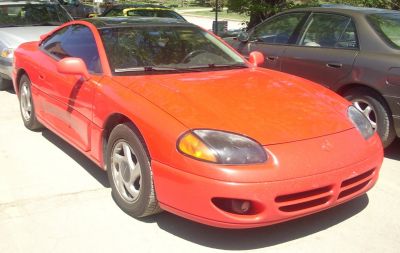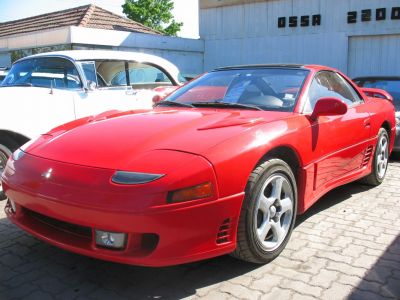 1994 Mitsubishi 3000 GT (facelift 1994) Dimensions, Size & Specs
1994 Mitsubishi 3000 GT (facelift 1994) Dimensions, Size & SpecsMeasurements of the 1994 Mitsubishi 3000 GT, engineered for optimal performance and comfort
| Dimensions | |
|---|---|
| Length: | 4565 mm179.7 in15.0 ft |
| Width: | 1840 mm72.4 in6.0 ft |
| Height: | 1253 mm49.3 in4.1 ft |
| Weight Specifications | |
| Curb Weight: | 1725 kg3803 lbs |
| Tire Specifications | |
| Rims Size: | 17-inch rims:
|
| Tire Size: |
|
The 1994 Mitsubishi 3000 GT facelift represents a refined version of Mitsubishi's iconic sports coupe produced from 1994 to 1997. This generation maintains the sleek and aggressive styling cues characteristic of the 3000 GT while offering improved aerodynamics and updated features. Measuring 4565 mm (179.7 inches) in length, 1840 mm (72.4 inches) in width, and standing at a low height of 1253 mm (49.3 inches), the 3000 GT coupe's dimensions underscore its sporty stance and road presence. Weighing in at 1725 kg (3804 lbs), the vehicle has a curb weight that balances performance and stability, contributing to its dynamic driving capabilities. The car rolls on 17-inch rims sized 8.5J with 245/45 R17 tires that enhance traction and handling, ensuring confident cornering and road grip. The 3000 GT facelift coupe of 1994 is a notable model among Japanese sports cars for combining advanced technology, such as all-wheel drive and active aerodynamics, with its compact yet muscular footprint. This generation fits comfortably within the mid-size sports coupe segment, appealing to enthusiasts who appreciate a blend of style, technology, and driving excitement. Its balanced dimensions and weight make it competitive against contemporaries, while its distinctive design maintains Mitsubishi's legacy as a manufacturer of performance-oriented vehicles.
Discover the standout features that make the 1994 Mitsubishi 3000 GT a leader in its class
Have a question? Please check our knowledgebase first.
The 1994-1997 Mitsubishi 3000 GT facelift has an overall length of 4565 mm (179.7 inches), a width of 1840 mm (72.4 inches), and a height of 1253 mm (49.3 inches). These dimensions contribute to the car's sporty coupe profile, giving it a sleek and aerodynamic appearance that was quite advanced for its time. The relatively low height enhances its aerodynamic efficiency and sporty stance, while the width provides a stable and planted feel on the road.
The curb weight of the Mitsubishi 3000 GT facelift (1994-1997) is approximately 1725 kg (3802 lbs). This weight is typical for a performance coupe of its era, influenced by its all-wheel-drive system, active aerodynamics, and multiple onboard technologies such as active suspension and four-wheel steering in some models. The weight contributes to a solid feel on the road, improving stability and cornering. While heavier than some sports cars, the powerful V6 engine and advanced drivetrain help maintain impressive acceleration and driving dynamics.
The 1994-1997 Mitsubishi 3000 GT facelift models typically come equipped with 17-inch wheels, with rim dimensions of 8.5J x 17. The tire size fitted to these rims is generally 245/45 R17. This tire size provides a good balance of grip and ride comfort, contributing to the car's sporty handling characteristics. The wider tire footprint enhances traction, especially important for the all-wheel-drive variants, while the 17-inch rims maintain a balance between performance and road feedback.
The 1994-1997 Mitsubishi 3000 GT facelift, with dimensions of 4565 mm (179.7 in) in length, 1840 mm (72.4 in) in width, and 1253 mm (49.3 in) in height, generally fits comfortably within a standard single-car garage. Most single-car garages have internal dimensions around 3000 mm (10 ft) in width and 6000 mm (20 ft) or more in length, so the coupe’s size is well within those limits. However, considering some clearance for opening doors and maneuvering, the 3000 GT should fit without issue, but owners in very tight or compact garage spaces should measure to be certain.
Compared to the earlier pre-facelift 3000 GT models produced between 1990 and 1993, the 1994-1997 facelift maintained very similar overall exterior dimensions, with minor design changes rather than dimensional changes. Both generations share roughly the same length (~4565 mm), width (~1840 mm), and height (~1250 mm). The facelift focused more on updated styling, aerodynamic improvements, and mechanical enhancements rather than resizing the vehicle footprint. The curb weight saw slight variation depending on options and markets but remained close to 1700-1750 kg.
The 1994-1997 Mitsubishi 3000 GT facelift sits squarely among the larger sports coupes of the 1990s. Its length of 4565 mm (179.7 inches) and width of 1840 mm (72.4 inches) make it comparable to rivals like the Toyota Supra Mark IV and Dodge Stealth, which shared similar platform traits. In terms of footprint, it is larger and heavier than many traditional two-door sports cars but smaller or similar in size to grand tourers. The 3000 GT’s size supports its grand touring nature with a roomy cockpit and advanced tech, while still delivering sporty handling.
Inside the 1994-1997 Mitsubishi 3000 GT facelift, the passenger space reflects a driver-focused yet comfortable layout typical of a 2+2 sports coupe. The cabin provides a snug front area suited for driver and passenger comfort, with supportive seats. Headroom and legroom align with the coupe’s low height (1253 mm / 49.3 inches), so taller passengers might find rear seat space limited, as is common in this class. The rear seats are best reserved for short trips or smaller passengers, emphasizing the car’s focus on sporty driving ergonomics over extensive cabin space.
The 1994 facelift of the Mitsubishi 3000 GT introduced several aesthetic and functional updates without drastically changing the core mechanical layout. Key improvements included revised front and rear styling for a fresher appearance, aerodynamics enhancements such as improved underbody panels and spoilers, and updated interior trim for greater comfort and refinement. Mechanically, some models received refined suspension tuning and minor engine tweaks to improve reliability and performance consistency. Overall, the facelift refreshed the model to stay competitive through the mid-1990s.
Beyond the standard 17-inch rims (8.5J x 17) with 245/45 R17 tires, owners of the 1994-1997 Mitsubishi 3000 GT facelift often upgrade to wider or larger wheels for enhanced grip and aesthetics. Common upgrades include 18-inch wheels with performance tires such as 245/40 R18 or 255/40 R18 sizes, improving handling and track performance. These upgrades require consideration of suspension clearance and potential effect on ride quality. OEM and aftermarket options provide a range of styles to fit the 3000 GT’s sleek profile while maintaining proper fitment.
With a curb weight of approximately 1725 kg (3802 lbs), the Mitsubishi 3000 GT facelift is relatively heavy for a sports coupe, primarily due to its all-wheel-drive system, active suspension, and electronics. This weight impacts fuel economy by increasing fuel consumption compared to lighter two-wheel-drive sports cars. Typical fuel economy ranges from about 12-15 liters per 100 km (approximately 16-20 mpg). However, the vehicle remains practical for daily use with a comfortable ride, solid road manners, and usable cargo and passenger space for a coupe of its class.
Discover similar sized cars.

| Production: | 1990-1996 |
|---|---|
| Model Year: | 1991 |
| Length: | 4565 mm179.7 in |
| Width: | 1840 mm72.4 in |
| Height: | 1247-1253 mm49.1-49.3 in |

| Production: | 1970-1976 |
|---|---|
| Model Year: | 1970 |
| Length: | 4485 mm176.6 in |
| Width: | 1820 mm71.7 in |
| Height: | 1190 mm46.9 in |

| Production: | 1990-1993 |
|---|---|
| Model Year: | 1990 |
| Length: | 4555-4565 mm179.3-179.7 in |
| Width: | 1840 mm72.4 in |
| Height: | 1247-1285 mm49.1-50.6 in |
